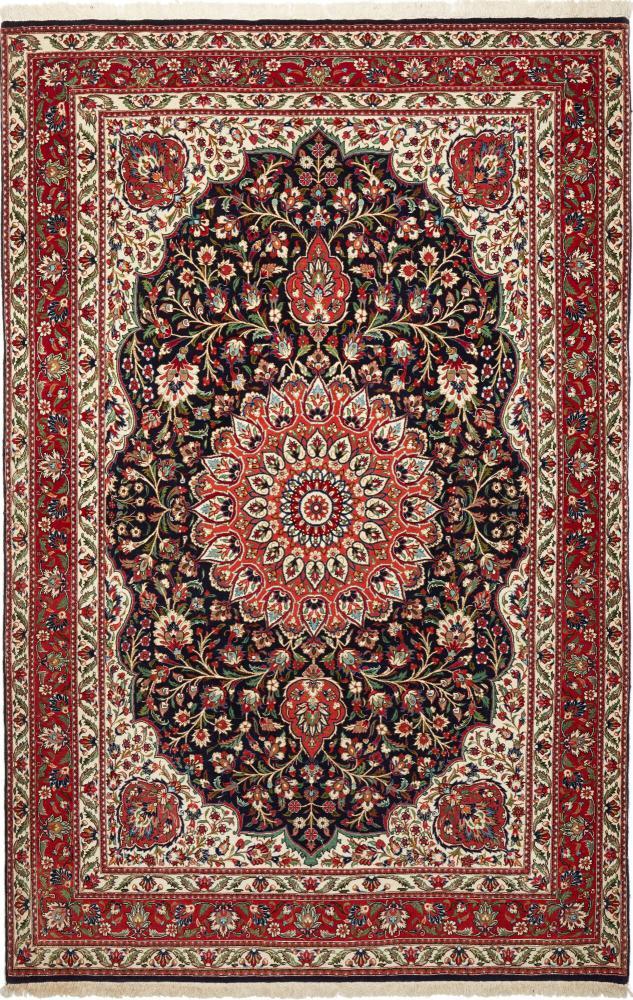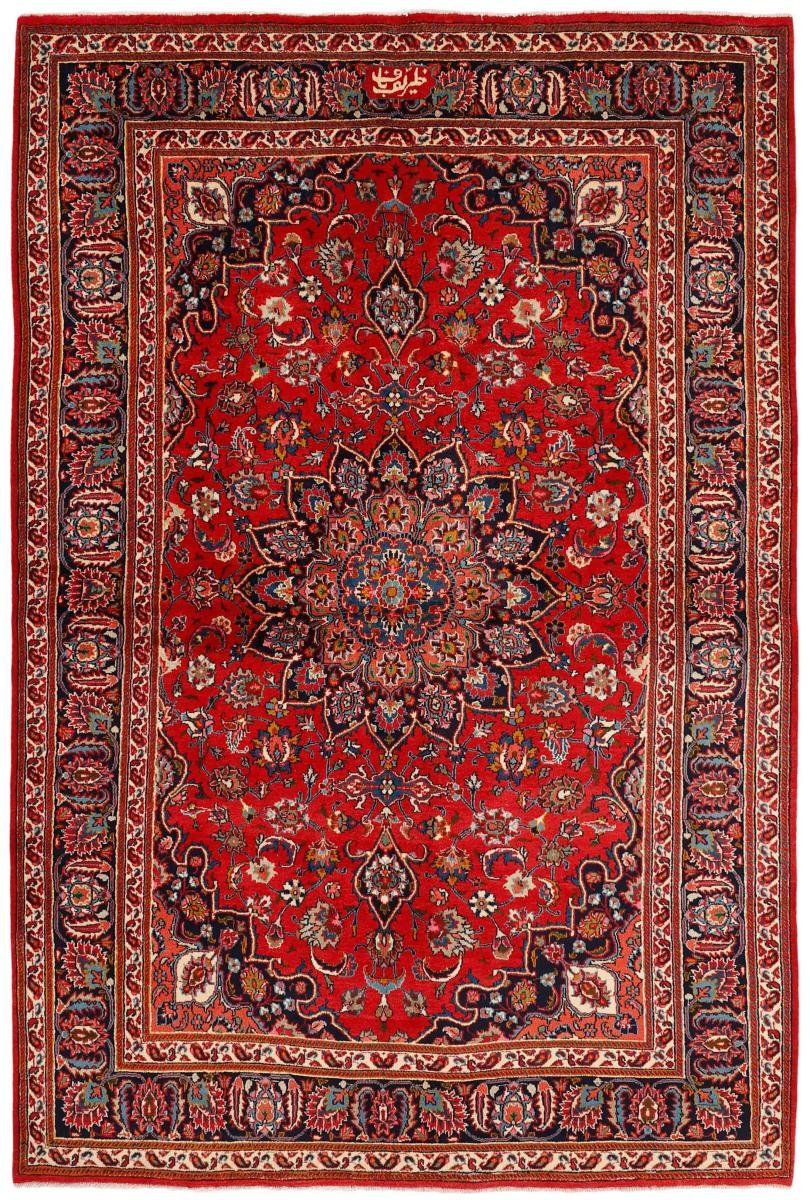Historical and geographical features of Gonabad city
Gonabad is one of the old cities of Iran and its construction is considered to be related to the period of Achaemenid kings. People like this Hoqal named this city as "Biyabad", Moghdisi and Yaqut Hamavi called it "Janabz" and spoke about Gonabad in their historical books. In the beginning of the Safavid dynasty, this city was a place of conflict between Iran and Uzbekistan for a long time. Jame Mosque of Gonabad is one of the famous historical monuments that belongs to the early 7th century of Hijri. Currently, Gonabad is located in the center of Khorasan province and approximately 270 km south of Mashhad. This city reaches from the north to Kashmir and Torbat Heydarieh, from the south to Firdous and Qain, from the west to Bajestan and Kavir Namak, and from the east to the eastern plains to the border of Afghanistan.
History of carpet weaving in Gonabad
Gonabad can be placed among the group of carpet production and supply areas in Khorasan, whose history of contemporary carpet weaving dates back to the years before World War II, i.e. around 1318 AH. Probably, in one or two decades before the beginning of 1300 AH century, carpet weaving in the style and method of today's Khorasan carpets and with a new style was common in this city. Although today carpet weaving in Gonabad is not comparable to other cities of the province in any way and the decrease in the quality of their weaves is evident to some extent, but historical sources show the remarkable activity of this area in the past years. But unfortunately, today, with a tour of the small and limited streets of Gonabad, except for a handful of shops, it is not possible to find a significant place to see and buy the handlooms of this region.
Decrease in production and quality of carpet weaving in Gonabad
Despite the existence of necessary facilities and conditions and the supply of raw materials for carpet weaving, especially in recent years, the people of this city have not shown a significant desire and tendency for quantitative and especially qualitative improvement in this part of the regional economy, and in other words, in this part of economic activity, and despite The increase in the number of carpet weavers in the region, there has been no development and movement towards the improvement of this industry, and therefore, the name of Gonabad is less visible in the field of rug weaving in Greater Khorasan Province. But the thing that attracts the attention of every researcher, enthusiast and buyer of the carpet weaving industry in this area about Gonabad carpets is the type and quality of the products of recent years, and in addition, the special history of Gonabad in the field of weaving high-quality carpets. A history that shows the special attention of the influential and elders of this area to carpet and carpet weaving, and this itself can show and prove the deep roots of carpet weaving among the people of Gonabad and its surroundings.
Important periods in the history of Gonabad handwoven carpets
In general, according to the available information, carpet weaving in Gonabad can be divided into 2 relatively distinct periods. The biggest difference between the productions of these two periods is in terms of the design style and roles used.
1- The first period: from the beginning of carpet weaving to before the Second World War, that is, until approximately 1318 AH. At this time, the use of designs ordered by German and English companies had occupied a special part of Gonabad carpet designs or left a special impact on the designs of other carpets.
2- The second period: the period after the war and the trend towards the original designs of Khorasan, especially the Lakh and Taranj of Shah Abbasi and Afshan Shah Abbasi along with the preservation of the lower register, is the characteristic of the carpets of this period, which in recent decades, due to the preservation of these designs and no change And the change in the roles and simply increasing the number of carpets to a maximum of 30 and 35 shows the preservation of the old ways of weaving and the lack of enthusiasm for transformation and innovation during the past 50 years.
Carpet weaving centers in Gonabad
Among the important areas of carpet weaving around Gonabad, we can mention the villages of Bagh Asiyab and Bailand in Doloi district, as well as the villages of Rahn, Variab in Homah district, and the village of Noghab, which are the oldest carpet weaving areas in Gonabad, and the history of carpet weaving in them probably dates back to the early years of The beginning of this industry goes back to Gonabad. According to the claims and evidence of many experts, Bagh Asiyab village, which is known as Bagh Siah among the residents, is the first area in Gonabad where carpet weaving began. The connection of two foreign companies affiliated with Germany and England in the years before 1317 with carpet manufacturers in Gonabad, especially in Bagh Asiyab, is one of the main reasons for the antiquity and importance of carpet weaving in Gonabad, especially in the mentioned village.

The most famous carpet manufacturers in Gonabad
Morteza Ahmad Bagh Asiai was one of the most famous and well-known manufacturers of handwoven carpets in Gonabad, and an important part of his productions was based on designs commissioned by foreign companies. At the same time as Morteza Ahmad Bagh Asiyabi, Qavam Naseri in Rabab village and Moin al-Ashraf in Noghab village located 3 kilometers south of Gonabad, who were among the rich and influential people of that time, were also active as other prominent manufacturers of handwoven carpets in Gonabad region, which According to many people, they have more records than Morteza Ahmad Bagh Asiai in terms of age and history of activity in this field. But according to the carpet traders and artisans, the products of Morteza Ahmed's workshop have a special quality and superiority. There is no information about Qawam Naseri and his activities, but after the death of Moin al-Ashraf, his son named Haj Agha Asafar continued his father's work. All his products were sold under the brand of Al-Tajjar. The date of death of these two weaving artists is before Morteza Ahmed Bagh Asiabi.
Among other famous people in Gonabad hand-woven carpets, we can mention the famous artist Seyed Hassan Saleh Ali Shah. Saleh Ali Shah, the son of Melanur Alishah, was one of the mujtahids of his time, and his court, his father's and his son's court is now a pilgrimage site for many. Although Saleh Ali Shah himself was not skilled in the weaving and principles of carpet weaving, but by his order, a large number of exquisite carpets were woven in Biddekht Gonabad, all of which were intended to furnish the shrine of his late father Noor Ali Shah, according to the quote of one of the old merchants and weavers of Gonabad. who had purchased some of their old and valuable weaves about 30 years ago, the words "Ho 121" can be seen on the top of the carpet and on the small border of all these carpets. All these carpets were bought by traders and buyers in Gonabad, Mashhad and Tehran, and currently there are no examples of them available. Ali Jan Mahmoodzadeh and Haj Abbas Ali Bailandi are other producers of Gonabad from long ago, whose carpets are very rare and were among the most famous carpets in the region in their time. At the same time as Qawam Naseri in Variab and Moin al-Ashraf in Noghab, Ali Shariatzadeh was one of the other carpet producers in Joymand village of Gonabad.
Technical features of weaving in Gonabad carpets
- Type of knot: Currently, the use of Turkish and Persian knots together is one of the characteristics of Gonabad carpets. They usually use Persian knot in the south of Gonabad and Turkish knot in the north.
- Type of tufting: tufting in Gonabad carpets is done in the Turkish way and on a loom. This practice has been going on in this city for nearly 40 years. The use of multi-ply weaving method (removal of thin weft) is one of the common defects of carpets like in other areas of Khorasan, which unfortunately can be seen in different areas of Gonabad as well.
- Payment and handling: Carpet payment in Gonabad is done after finishing the carpet and using electric scissors.
- Shirazeh carpet weaving: Perhaps the most important difference between the weaves of the Gonabad region and its northern regions such as Kashmir, Neishabur and Mashhad is the shirazeh carpet weaving. The work that is done in the carpets of the northern areas of Khorasan is done after the carpet is finished.
- Gonabad carpet dyeing: Currently, in terms of dyeing, the largest vegetable dyeing factory has started its operation in Gonabad, and the safflower dyeing workshop supplies a large part of raw materials to the weavers of Gonabad and even Khorasan. Of course, another part of the raw materials used by the weavers of Gonabad and its suburbs is the skeins dyed using chemical dyes, which are prepared and brought to the market from nearby cities.
- Carpet texture similar to Nayin in Gonabad: The texture of carpets with special design and coloring of Nayin has been popular in Gonabad for almost two decades.
- Count: The count of Gonabad carpets is usually between 30 and 35 and rarely exceeds 40 rows. Therefore, the carpets of this area are average and low in terms of fine texture.
- Dimensions: The common dimensions of today's carpets in Gonabad region are generally 3 x 2 and 3.5 x 2.5. Rarely larger dimensions are also seen.
- Carpet weaving: Carpet weaving in Gonabad carpets is also in Persian style and is done using thick weft. The carpets of this region are double weft style (one thick weft and one thin weft) and they often tend to have a loop weave.
You can inquire about Buying Handwoven Carpets , Buying Handwoven Kilim and Mats , and Buying Handwoven Pictorial Rug Tableaus online from the Hoveida Carpet Store and register all your orders and Wherever you are in the world, deliver it to the desired address in less than 4 working days.
If you are interested in reading other articles in the field of Handwoven carpets or Handwoven Pictorial Rug Tableaus , please refer to Hoveida Carpet Commercial
Leave a comment
Your email address will not be published. Required fields are marked *












